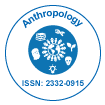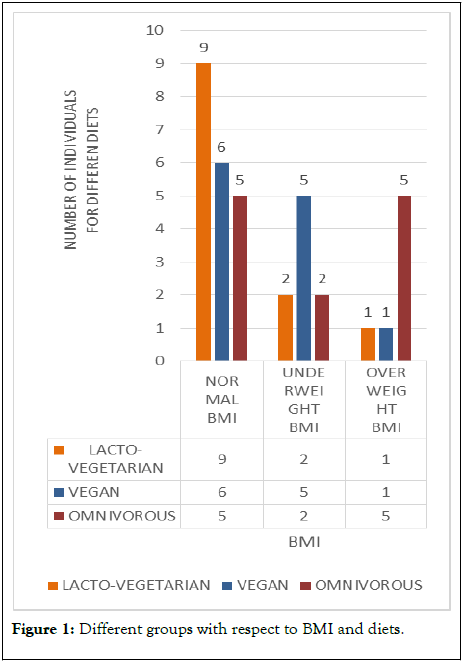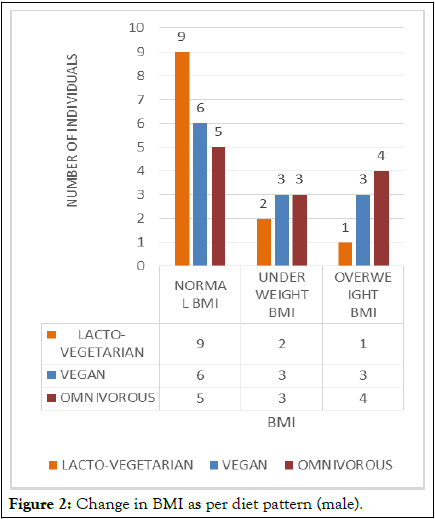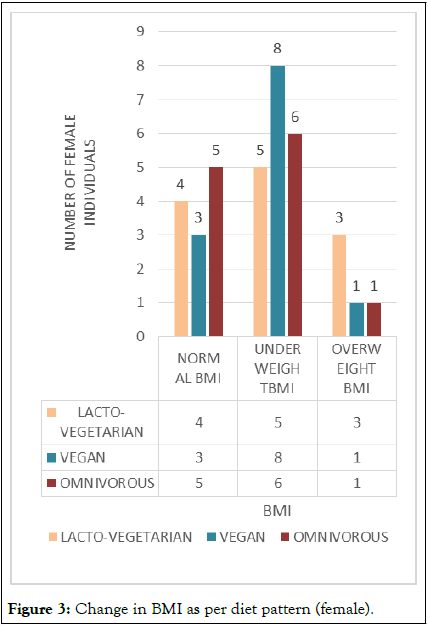
Anthropology
Open Access
ISSN: 2332-0915

ISSN: 2332-0915
Research - (2025)Volume 13, Issue 1
Anthropometric profile and food intake behaviour plays an important role in monitoring health conditions and nutritional status of diet consuming population. The aim of the study was to find out the anthropometric measurements of people consuming vegan, lacto-vegetarian and non-vegetarian/omnivorous diet. Impact of different diet consuming population was calculated on health aspects in terms of BMI. Hence, in this regard a survey was conducted of total 139 respondents to calculate BMI of lacto vegetarian, vegetarian and non-vegetarian groups of categories. The survey reflected BMI rate of lacto-vegetarian was better (75%) than other diet consuming population also shows that vegan diet is more prone to have underweight issues in females (41.7%). The study also depicts that male group of non-vegetarian/omnivorous categories are higher risk of obesity and overweight issues, therefore suggesting them to consume plant based diet with dairy food as dietary intake in order to maintain normal BMI.
For our daily activity we all need food to work, we consume various food items to intake many biomolecules for functioning of our metabolism, to survive, continuous growth and reproduction. Humans (Homo sapiens) are gradually modifying their lifestyle and learning to become dominant amongst all species [1]. In modern period we not only take precautions on our diet but also for animal’s fodder. We consume food sources either from plants or from animals. On the basis of sources diets are classified into vegetarian and non-vegetarian. However, there are different kinds of diets on the basis of combinations of plant products and animal products like pesco-vegan, pseudovegetarian, lacto-ovo-vegetarian etc. There are certain barriers into diets of food choices that enable a person to eat some food stuffs. These barriers are 1) Bad odour, 2) Ritual importance, 3) Health issues, 4) Society boundations, 5) Lack of information and 6) Poverty [2].
The advancement in the food technology enables vegetarian to consume high protein diet as a substitute of meat, which are characterized by having high cholesterol and calories. Recent study of Mohamed, et al. showed that meat-based diets are creating serious problems like obesity and heart diseases [3]. A report published by Elli, et al. highlighted the problem arises with the school aged children and some adults that are allergic to gluten which is found in wheat (Triticum aestivum), rice (Oryza sativa), maize (Zea mays) floors and create problem like atopic dermatitis, IgE mediated reactions including urticaria, angioedema, bronchial, obstructions, nausea, anaphylaxis and abdominal pain [4]. Some of the people are allergic to egg and milk too. Such people are advised to eat curd or processed milk products.
Vegetarian diet becoming popular in all over the world. In India it is suggested by religious groups and philosophers since ancient time. Now a day’s yoga is also getting attention in most of the countries in which vegetarian diet is recommended. In younger countries like India vegetarian diet is followed from the school aged children in form of mid-day meals or lunch [5]. Such practices will encourage them to adopt vegetarian diet and to understand positive impact on health. The vegetarian diets are recommended by dieticians due to their dense nutrient nature and for weight management without compromising diet quality [6]. Adolescent Micronutrient Quality Index (AMQI) is used as a useful measure of the dietary adequacy and micronutrients quality of diets Indian adolescence teenagers specially of girls that are consuming lacto-vegetarian diet.
Centre for Disease Control and prevention (CDC) considered the anthropometric measurements as non-invasive approach for assessment of nutritional status in human body. It is also helpful to assess social health, dietary status and disease risk in future [7]. Major six core elements of anthropometry are weight, height, fatness, skinfold thickness and Body Mass Index (BMI). These measurements can also be used to determine nutritional status in pregnant women [8]. The BMI is use for population based studies of health issues especially as a determinant of body fat mass however gender, age, leg length and ethnic group are considered as important variables [9].
In previous studies it is observed that different daily routine followed by the people can affect type 2 diabetes level in terms of BMI of different diets like vegan which have lower BMI, lactovegetarian, pesco-vegetarian, lacto-ovo-vegetarian is incrementally higher, however omnivorous was maximum [10].
By analysis of BMI, Rosell, et al. found that people of UK, who consumed meat and fish had maximum mean weight gain than the people consuming vegan diet [11]. Lacto-vegetarian diet is different from normal vegetarian diet in terms of one animal product called milk, to incorporate vitamin B12 in human diet and found to decrease the risk of coronary heart diseases indicated by surrogate markers [12]. Lowik, et al. reported that pure vegetarian elderly is at a higher risk for a marginal iron, zinc and vitamin B12 status [13]. Other main constituents of milk are given in Table 1.
| Main contents | Variation | Mean (%) | Role in human body |
|---|---|---|---|
| Water | 85.5-89.59 | 87.5 | Important in human metabolism, transport of nutrients like glucose and oxygen |
| Total solids | 10.5-14.5 | 13.0 | It helps to determine nutrient enrichment in milk |
| Fats | 2.5-6.0 | 4.0 | Components of cell membrane, energy source and hormones |
| Protein | 2.9-5.5 | 3.4 | Fundamental building blocks of muscles, skin, hair and cellular components |
| Vitamin B12 | 0.40-0.45 | 0.40 | It is a water-soluble vitamin involve in protein metabolism and blood function. Its deficiency causes anaemia or nervous system injury from lower-than-normal amount of vitamin B12 |
| Lactose | 3.6-5.5 | 4.8 | Is an enzyme lactase is needed to turn lactose into glucose and used as the source of energy |
| Minerals | 0.6-0.9 | 0.8 | Functions include enzyme function, bone formation, water balance maintenance and oxygen transport |
Table 1: Main contents of milk and their role in human body.
Objectives
Keeping above view in mind present study was undertaken with the following objectives:
• To calculate impact of consuming diet on the health of respondents in terms of BMI.
• To find out impact of different diets on the health of respondents based on gender differences.
To accomplish above objectives, an online survey was conducted through Google form. All responses were collected and analyzed statistically. Total 139 respondents from four cities of Utter Pradesh were participated in the survey. BMI is the relation of body weight (kg) and height (meter) of a person, or we can write in equation:

Above equation was given by Lambert Adolphe Jacues Quetelet in 1835 for calculation of ‘Quetelet Index’. Letter in 1972 Ancel Benjamin Keys coined it as Body Mass Index (BMI) [14].
In present study the calculated values of BMI were compared with reference values given in Table 2.
| Weight | |
|---|---|
| Underweight | 15-19.9 |
| Normal weight | 20-24.9 |
| Overweight | 25-29.9 |
| Preobesity | |
| Class I obesity | 30-34.9 |
| Class II obesity | 35-39.9 |
| Class III obesity | Equal or more than 40 |
Table 2: Reference values of BMI and categories.
Observance from objective 1
In present survey the weight (kg) and height (m2) of total 139 respondents consuming vegan, lacto-vegetarian and omnivorous diets were collected and used to calculate their Body Mass Index (BMI). Out of 139 people 12 people from each diet consuming category were randomly selected and used to categorize in three groups i.e., normal, underweight and overweight. Results showed in Figure 1 indicated that total individuals having normal weight were 9, 6 and 5 that following lacto-vegetarian, vegan and omnivorous diets respectively. On the other hand maximum underweighted were found in the vegan diet consuming group. Interestingly maximum overweight individuals were found in the omnivorous group. The findings are in conformation with the previous study done by Rosell, et al. in which he stated that the people of UK, who consumed meat and fish had maximum mean weight gain than the people consuming vegan diet.

Figure 1: Different groups with respect to BMI and diets.
With the results, we can conclude that the rate of BMI is better in the lacto-vegetarian diet in all weight groups.
Observance from objective 2
Gender (Male/Female) of the respondents was recorded through question no 4 of the questionnaire. Out of 139 respondents female were 81 (58.3%) and male were 58 (41.7%). Randomly 12 individuals were selected for calculating BMI from both the gender groups. This was done to find out number of male and female consuming vegan, lacto-vegetarian and omnivorous diet and to find out their health status (Figure 2).

Figure 2: Change in BMI as per diet pattern (male).
All male respondents were divided in three categories based on their BMI. Results showed in Figure 2 showed that in terms of normal BMI maximum 9 (75%) and minimum 2 (16.6%) respondents were found underweight in the lacto-vegetarian diet group. On the other hand maximum 4 (33.33%) overweighed people were found in omnivorous followed by vegan (25%) and lacto-vegetarian (8.33%) respectively.
Hence, from data it is clear that lacto-vegetarian is a better diet for male.
From Figure 3 it is clear that among lacto-vegetarian females 33.3% having normal BMI while 41.7% underweighted and 25% were overweight. In vegan diet 25.1% females were normal weighted, 66.6% underweighted and 8.3% were found overweight. Surprisingly out of 12 females consuming omnivorous diet 41.6% were normal weighted, 50% were underweighted and 8.4% of females were found overweighed.

Figure 3: Change in BMI as per diet pattern (female).
Hence, in case of females the omnivorous diet was found better to give better health followed by lacto-vegetarian and vegan. From results it is suggested that females should avoid vegan diet as it is more prone to give underweight individuals.
Scope of future work
This study was a descriptive way to show the best diet out of three types i.e., lacto-vegetarian, vegan and omnivorous. Further researchers can research can be done on the nutrient contents level in all three diets and to make comparative charts to assure which type of diet is more nutritive. From present survey it is suggested that a cross check study in different states should be done to understand the diet consumption and health status of the Indian people.
[Crossref] [Google Scholar] [PubMed]
[Crossref] [Google Scholar] [PubMed]
[Crossref] [Google Scholar] [PubMed]
[Crossref] [Google Scholar] [PubMed]
[Google Scholar] [PubMed]
[Crossref] [Google Scholar] [PubMed]
[Crossref] [Google Scholar] [PubMed]
[Crossref] [Google Scholar] [PubMed]
[Crossref] [Google Scholar] [PubMed]
Citation: Mehta P, Karuna, Yadav S (2025) Anthropometric Study of Different Diet Consuming Population. Anthropology. 13:254.
Received: 27-Dec-2023, Manuscript No. ANTP-24-28689; Editor assigned: 29-Dec-2023, Pre QC No. ANTP-24-28689 (PQ); Reviewed: 12-Jan-2024, QC No. ANTP-24-28689; Revised: 22-Jan-2025, Manuscript No. ANTP-24-28689 (R); Published: 29-Jan-2025 , DOI: 10.35248/2332-0915.25.13.254
Copyright: © 2025 Mehta P, et al. This is an open-access article distributed under the terms of the Creative Commons Attribution License, which permits unrestricted use, distribution, and reproduction in any medium, provided the original author and source are credited.